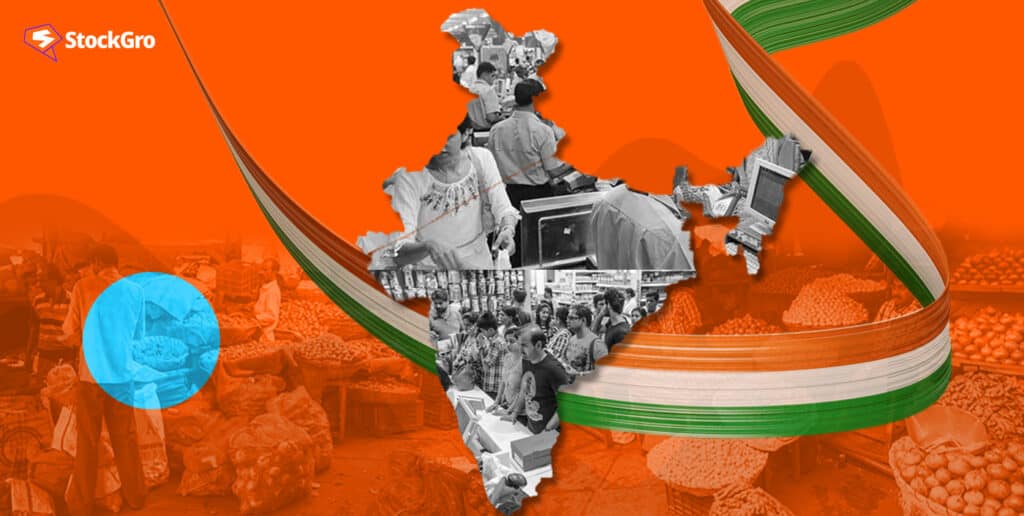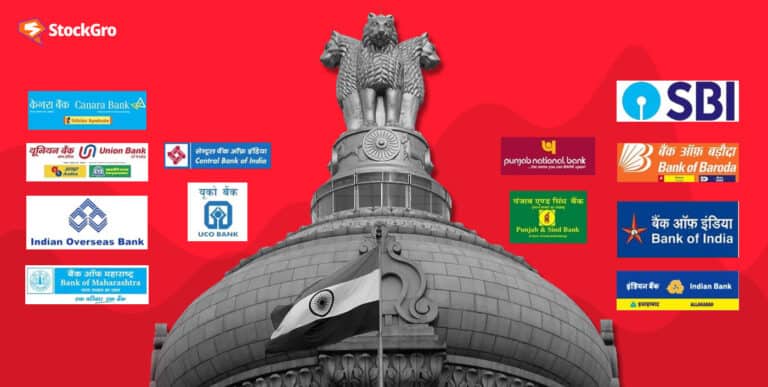
The Indian consumer market is full of life and energy thanks to the country’s huge population and booming economy. It’s an intriguing study ground for marketers and businesses due to the diverse cultures, languages, and consumer behaviours found there.
Not only is the Indian consumer market massive, but it also can shape buying habits around the world.
The purpose of this article is to explore the complexities of the Indian consumer market by illuminating its growth, features, significant segments, and business opportunities. Keep reading as we explore the dynamic Indian consumer market.
Market size and growth
The Indian consumer market stands as a behemoth, poised for unprecedented expansion and transformation in the coming years. The market is projected to soar to a staggering worth of $6 trillion by the year 2030 and $10 trillion by the year 2035. This exponential growth trajectory is underpinned by a confluence of dynamic factors, including rapid urbanisation, ascending incomes, and the demographic dividend conferred by India’s youthful population.
Urbanisation continues to reshape the landscape of India’s consumer market, with an increasing number of individuals migrating to urban centres in search of better opportunities and improved living standards.
Housing, transportation, the consumer electronics market in India, and entertainment are just a few of the many goods and services that are in high demand as people move from rural to urban areas. This urban migration trend is expected to persist, further bolstering the growth of the consumer market.
| Share of migrants | Rural | Urban |
| Male | 5.9% | 22.5% |
| Female | 48% | 47.8% |
| Overall | 26.5% | 34.9% |
The steady rise in per capita incomes, accompanied by the expansion of the middle class, plays a pivotal role in driving consumer spending in India. As incomes climb, so do consumer aspirations, leading to heightened demand for premium products, luxury goods, and experiential services.
Demographic dividends
India’s demographic profile, characterised by a median age of 28.4 years and over 65% of the population below the age of 35, presents a significant advantage for consumer-driven industries. This youthful population not only signifies a large consumer base but also implies a high propensity for consumption, as younger individuals tend to spend more on discretionary items.
Moreover, with the median age projected to rise gradually, there’s a window of opportunity for businesses to tap into the spending potential of the younger demographic segments, such as millennials and Gen Z.
As a result of a demographic shift, India’s median age has been rising steadily over the last several decades. For instance, the median age of India’s population rose from 24.3 years in 2000 to 32.4 years in 2020, reflecting both improvements in healthcare and changes in lifestyle.
The youth demographic, comprising millennials and Gen Z, plays a pivotal role in shaping consumer spending patterns. With their increasing purchasing power and preference for personalised experiences, businesses are adapting their marketing strategies to cater to these segments. Personalisation has become one of the most indispensable consumer marketing Indian strategies, allowing businesses to engage with consumers on a more individualised level.
Affluent and politically active youth in India are driving demand for brands that reflect their beliefs and values. Sustainable and ethical consumption is trending, and more and more people are gravitating towards brands that are good for the environment, the people who work in the supply chain, and society as a whole.
Additionally, the desire for personalised experiences and tailored offerings is reshaping the retail landscape, prompting brands to innovate and differentiate to cater to individual preferences.
Key consumer segments in India
FMCG (Fast-Moving Consumer Goods)
The FMCG sector, valued at $307.2 billion in the year 2022, is expected to reach $547.3 billion by 2028. The dynamics of the country’s consumer market are driven by this sector.
In the face of overwhelming economic uncertainty, rural markets emerged as strongholds, demonstrating the FMCG industry’s remarkable resilience in the face of the COVID-19 pandemic. Notably, the pandemic-induced lockdowns led to shifts in consumer behaviour, with a heightened emphasis on health, hygiene, and convenience driving demand in key FMCG categories.
Cities that are significant for fast-moving consumer goods producers include:
- Chandigarh
- Maharashtra
- Tamil Nadu
- Gujarat
- Punjab
Throughout the pandemic, rural areas demonstrated robust demand for consumer goods market in India, outpacing urban centres. Factors like better distribution networks, increasing agricultural incomes, and more government investment in rural development are to blame for this trend. Understanding and leveraging this trend is crucial for FMCG companies aiming to capitalise on the untapped potential of rural consumers.
The FMCG sector witnessed a notable surge in online sales during the pandemic, with consumers turning to e-commerce platforms for their everyday needs. This shift towards digital channels necessitates FMCG companies to enhance their online presence, optimise supply chain logistics, and tailor marketing strategies to cater to the evolving preferences of digital consumers.
Moreover, consistent gains in discretionary income and advances in technology are driving up demand for a variety of consumer durable markets in India.
Major stocks in FMCG:
| Company | Share price (NSE) (in ₹) | Share price (BSE) (in ₹) | Market capitalisation (NSE) (in ₹ cr.) | Market capitalisation (BSE) (in ₹ cr.) |
| Nestle | 2,575.40 | 2,575.15 | 248,270.47 | 247,793.21 |
| Britannia | 4,902.60 | 4,905.45 | 118,073.64 | 118,221.77 |
| Adani Wilmar | 404.60 | 404.40 | 52,468.03 | 52,877.42 |
| Jubilant Food | 486.15 | 486.40 | 32,068.48 | 32,084.97 |
| Hatsun Agro | 1,102.95 | 1,101.45 | 24,559.17 | 24,534.66 |
Also read: Fast-Moving Consumer Goods (FMCG) Sector- A Safe Haven in Bear Markets?
E-Commerce
India’s e-commerce market is poised for significant expansion, projected to surge to $200 billion by 2026. With a CAGR of more than 30%, this trajectory shows a significant rate of growth. India has one of the world’s largest online populations, with over 700 million internet users as of March 2023. This trend is fueling the growth of e-commerce in the country.
Mobile commerce (m-commerce) has been on the rise in India due to the abundance of smartphones and affordable data plans. Mobile commerce is expected to account for a significant share of total e-commerce transactions, further driving market expansion.
The penetration of Internet services in rural areas has been a crucial driver of e-commerce growth. Rural India has 30% more active users when compared to urban India, highlighting the untapped potential of these demographics for e-commerce expansion. The key to long-term success in the e-commerce market is learning about and meeting the specific demands of customers in rural areas.
The evolution of digital payment infrastructure, including the widespread adoption of Unified Payments Interface (UPI), has facilitated seamless transactions in the e-commerce ecosystem. The convenience and security offered by digital payment solutions have contributed to increased consumer confidence in online shopping, further driving e-commerce adoption.
Major stocks in E-Commerce:
| Company | Share price (NSE) (in ₹) | Share price (BSE) (in ₹) | Market capitalisation (NSE) (in ₹ cr.) | Market capitalisation (BSE) (in ₹ cr.) |
| Zomato | 165.45 | 165.35 | 145,658.73 | 145,791.03 |
| IRCTC | 977.50 | 973.90 | 78,632.00 | 78,760.00 |
| FSE E-Co Nykaa | 152.10 | 152.30 | 43,486.70 | 43,443.87 |
Also read: Overview of the e-commerce industry in India
Automobiles
Due to its importance in driving both technological development and overall economic growth, India’s car industry has long served as a reliable barometer of the country’s economic health. It is projected that by 2035, the Indian automotive industry will be worth $1 trillion.
There are several clusters formed in the automotive industry of India. The most giant clusters include:
- Mumbai-Pune-Nashik-Aurangabad
- Chennai-Bengaluru-Hosur
- Delhi-Gurgaon-Faridabad
- Kolkata-Jamshedpur
- Sanand-Hansalpur-Vithalpur
Two-wheelers and tractors, in particular, showcased robust performance, propelled by increased demand in rural areas. This shift in demand patterns emphasises the importance of understanding regional variations in consumer behaviour.
The industry is witnessing a significant surge in the adoption of electric vehicles. This change is being propelled by government incentives and consumers’ increasing concern for the environment. The trend aligns with global efforts towards sustainable and eco-friendly transportation.
Increasing digitalisation in the automotive sector is notable. From online sales platforms to connected vehicle technologies, the industry is embracing digital integration. This trend enhances the overall consumer experience, providing convenience and advanced features.
With a heightened focus on safety, there is a growing trend in integrating advanced safety features in vehicles. From autonomous driving capabilities to enhanced safety protocols, manufacturers are prioritising the well-being of consumers.
Major stocks in the automobile sector:
| Company | Category | Share price (NSE) (in ₹) | Share price (BSE) (in ₹) | Market capitalisation (NSE) (in ₹ cr.) | Market capitalisation (BSE) (in ₹ cr.) |
| Bajaj Auto | 2 & 3 wheelers | 8,477.00 | 8,463.40 | 240,108.12 | 239,588.48 |
| TVS Motor | 2 & 3 wheelers | 2,132.60 | 2,132.00 | 100,279.01 | 100,675.71 |
| M&M | Auto & Truck manufacturers | 1,944.25 | 1,944.40 | 241,058.06 | 241,654.96 |
| Tata Motors | LCVS/HCVS | 936.90 | 936.55 | 312,468.73 | 311,388.68 |
| Eicher Motors | LCVS/HCVS | 3,950.00 | 3,945.00 | 107,930.90 | 107,867.93 |
| Maruti Suzuki | Passenger Cars | 11,454.05 | 11,455.40 | 360,163.87 | 359,975.23 |
| Escorts Kubota | Tractors | 2,861.60 | 2,863.25 | 31,624.05 | 31,608.03 |
| Ashok Leyland | Trucks/LCVs | 173.70 | 173.80 | 50,809.68 | 50,883.09 |
Also read: Financing your next car purchase? India’s auto finance sector and lenders
Bottomline
The Indian consumer market is a dynamic and rapidly evolving landscape, offering a wealth of opportunities for businesses. With its diverse consumer base, rapid urbanisation, and increasing digital penetration, it presents a unique blend of challenges and opportunities.
The consumer market is anticipated to be crucial in determining the economic destiny of India as the nation progresses and expands.

